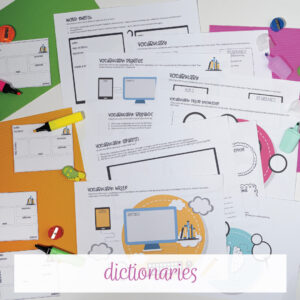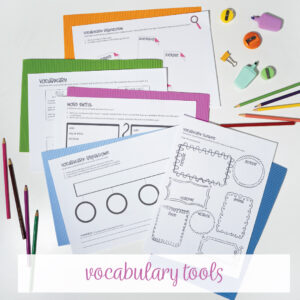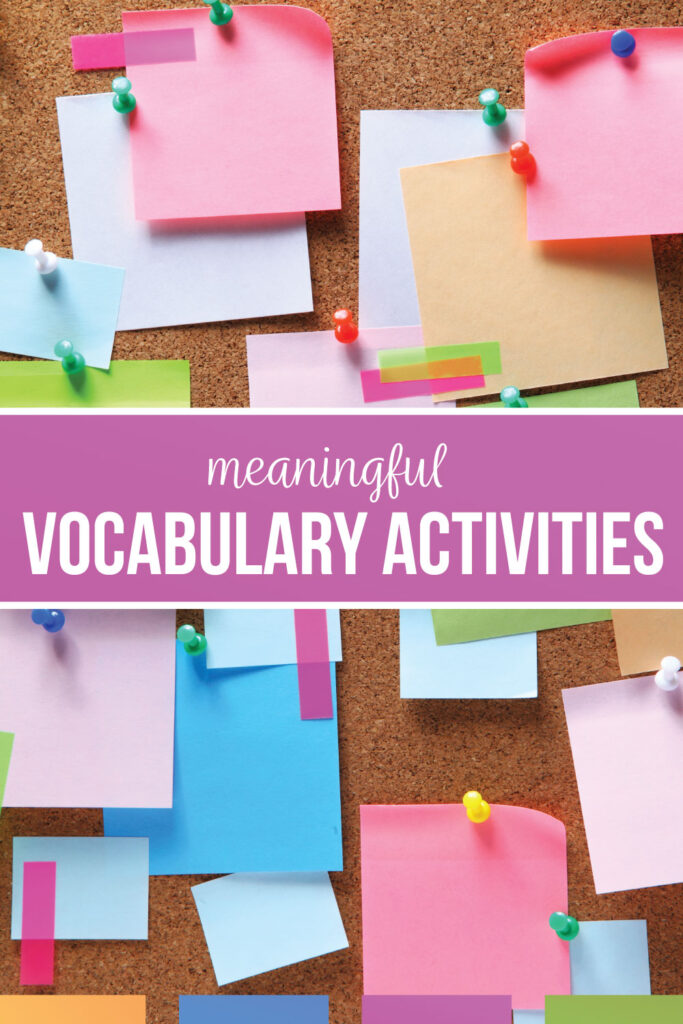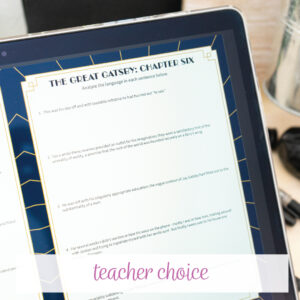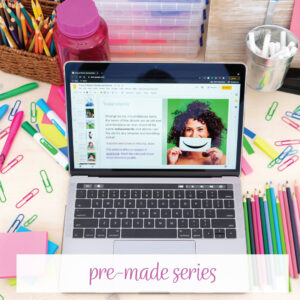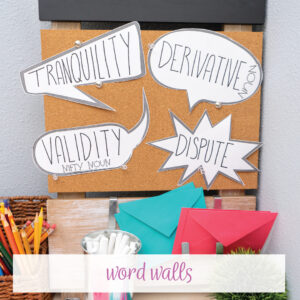Creating meaningful vocabulary for high school students. Hmmmm—and teaching vocabulary, in engaging ways?? Tall orders.
Word walls, mentor sentences, and repetition: It’s tough, and I believe it’s because older learners are jaded against such lessons. I don’t have all of the answers, but I can be honest about methods I’ve found meaningful. While researching this post, I discovered other methods worth examining. I’ll include links to those ideas later. Hopefully this post serves as a resource as you examine and implement vocabulary methods, discovering the most effective for your classes.
Overall, my best approach to meet advanced language standards (vocabulary for high school students is included in those standards!) is to provide everyone with choice about their tools. When I teach vocabulary, I provide bookmarks for choosing words and graphic organizers for analyzing the words.
However, before we dive into the various ways of approaching these lessons, let’s cover meaningful parts of covering vocabulary.
English Dictionaries for Modern Learners
So, we should acknowledge this: our classes have dictionaries on every device. With technology being such a prominent part of their lives, having dictionaries readily available on their devices ensures easy access to definitions, examples, and pronunciation of words. As teachers, we probably need to model using the dictionary.
These digital dictionaries offer more than just definitions; they provide context and usage examples to help classes understand how words are used in real-life situations. Additionally, many of these dictionaries have features like word games and quizzes, making the learning process interactive and engaging.
By incorporating these modern English dictionaries into our classes, we empower our everyone to take ownership of learning new terms.
What about Flashcards and Worksheets for Vocab Practice?
As a seasoned English teacher, I do not discard flashcards and worksheets to practice new terms. However, other tools exist in addition. One alternative method worth examining is the use of online flashcard platforms. These platforms allow learners to create and study virtual flashcards, making vocabulary practice more interactive and convenient. Additionally, many of these platforms offer features like audio pronunciation, a benefit for multiple grade levels.
Another tool that can be effective for vocabulary practice is the use of word association games and analogies. These games provide a fun and engaging way for students to expand their vocabulary by connecting words with related concepts or images. Vocabulary for high school students with images is not too babyish. This method not only helps improve their memory retention but also encourages creative thinking and deeper understanding of word meanings, prefixes, suffixes, and on.
Now that we’ve covered an overview, let’s examine some vocabulary activities for high school students, some basic ideas to give you confidence while teaching vocabulary, and methods for creating new vocabulary lists. 
1. Learner directed: Ask students to choose their words.
With this approach of acquiring words, students will choose terms to study from a reading assignment, most often a novel.
This method takes extra work because you won’t have a master for grading. I’ve also found that it’s labor intensive. Guiding students and encouraging them to uncover difficult words requires circling amongst everyone. Grading can be a completion check or quick overview of words. Another option is to compile the class’ commonly listed words and study those. This approach means that the work won’t be done ahead of time, which creates extra prep work for you.
Still, this is the vocabulary instruction I commonly use with my vocabulary for high school students. It gives them ownership, and I sense less grumbling from classes. At times, I provide structure and require certain words be included. They overall choose the words, and I merely serve as their assistant in learning.
When classes choose their vocabulary words, this can flow into writing assignments. For instance, you can have them write a sentence using a vocabulary word. Another option is to find a theme among the words and have them write a story based on the words’ message: gloom, excitement, destruction, promise.
2. Pre-made lists: Choose the words and have students attempt the definition from a text.
When reading fiction or nonfiction, choose vocabulary words ahead of time. Give readers the list and as they read, ask them to derive the meaning from the context. After finishing, everyone can correct their words with each other, a dictionary, or as a class.
First, students will practice using context clues. Furthermore as you review, you can explain the parts of speech, showing how grammar is part of what they read. To take it a step more, examine why the author used specific language. For instance in The Great Gatsby, we analyze Fitzgerald’s writing style through a linguistic lens.
Finally, do not feel bad about assigning specific words. Vocabulary learning takes time, and young readers might not be savvy enough for word consciousness.
3. Easy vocabulary for the high school student: Teach a word of the day.
Floating around Pinterest are dozens of “words every high school graduate should know” and “ACT prep” or “SAT” lists. Grab a list of unknown words, modify it if necessary, and add definitions. Teach one concept per day. This method can be in a no-stress way, by simply posting the word and reading it to start class. Students will remember those words, especially if you use them throughout the year in your lessons.
Many schools are creating robust vocabulary lists for the entire school to focus on. Your school may soon have such a list, and all teachers will incorporate that list in some manner. Another option is to borrow a list from a neighboring school.
To review, grab sticky notes and ask students to create a picture, sentence, or note that helps them remember the word and its definition. (Start with basic words if necessary.) Combine the sticky notes and complete a gallery walk with your class.
4. Vocabulary for high school students: Teach from a series.
Teaching vocabulary from a series is a bit like #3, but with more pre-made activities. If you are new to teaching vocabulary or need quick instruction, the web is full series with accompanying activities. Experiment with what your students enjoy and with what helps them learn the best. Create your own activities to supplement, or branch out with the above ideas.
Teaching from a series shouldn’t be the end-all, but can be a starting point. I use mentor sentences from a variety of books so that I can connect vocabulary to literature smoothly.
5. Fun and visual reminders: Word walls.
Yes, secondary students enjoy word walls. Ask students to assemble adverbs and adjectives from their vocabulary lists. Hang the words and discuss their meanings. As students created this visual, they will interact with it, especially if it becomes part of a bulletin board.
The goal is for students to review their vocabulary in multiple ways, study it multiple times, and to take ownership of the words. Vocabulary activities high school needn’t always be formal; a quick review with the word wall created by students will reinforce vocabulary lessons.
Research.
Like I previously mentioned, when I began writing this blog post, I researched best practices for vocabulary instruction. During my teaching training, I was taught that students needed to identify words for the instruction to be meaningful. I see validity with that point and most often use some variation of that when teaching high school students vocabulary. However, I have experienced students avoiding terms that intimidate them. The words that could create growth? Students ignore them.
One could argue that classes are still studying, but are they truly expanding their vocabularies? Teacher involvement is a requirement – involvement that uses the vocabulary orally and in writing. In “Research-based Practices in Vocabulary Instruction,” the authors say this:
Research recommends that students learn fewer words but that they know how words and the English language work so that they can infer the meanings of new words. Effective vocabulary instruction is characterized by deliberate selection of words to be taught and frequent opportunities for students to interact with the words in meaningful contexts. Interacting with words in multiple ways and in varied contexts results in durable word learning.
From reading “know how words and the English language work,” I take that to mean conventions, grammar, studying language. I’ve written about teaching grammar alongside vocabulary, and how students benefit from learning words associated with an English class, just as students use algebraic terms in an algebra class.
The study quoted above is not long, and contains links to other resources. If you teach with ‘tiered’ words, Edutopia has tips for that vocabulary instruction.
Teaching Vocabulary, Overall.
Teaching vocabulary for high school students is a must, and the variations will depend upon your classes’ needs and your experience. When I reflect upon my first years teaching, my vocabulary instruction was weak. Over time, I learned new methods and grew in my confidence in allowing everyone to participate more. Passive learning of new terms will not grow students’ vocabularies. Research different approaches, and experiment.
Collaborate with other teachers and learn vocabulary alongside your students. Finally, be open to various approaches when teaching vocabulary to high school students.


